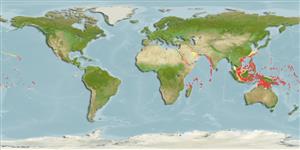分類 / Names
俗名 | 同種異名 | Catalog of Fishes(屬, 種) | ITIS | CoL | WoRMS | Cloffa
Teleostei >
Eupercaria/misc (Various families in series Eupercaria)
鱸形目 (Various families in series Eupercaria) >
Labridae (Wrasses)
隆頭魚科 (Wrasses) > Cheilininae
Etymology: Oxycheilinus: Greek, oxys = sharp + Greek, cheilos = lip.
More on author: Günther.
Environment: milieu / climate zone / depth range / distribution range
生態學
海洋 礁區魚類; 深度上下限 0 - 80 m (Ref. 9823). 熱帶; 30°N - 15°S
Indo-West Pacific: Red Sea, Indonesia to Ryukyu Is., Marshall Is.
西太平洋: 模里西斯,印尼到美屬薩摩亞,琉球群島,加羅林群島,馬紹爾群島與馬里亞納群島。 被接近地取代了在印度洋講 Oxycheilinus mentalis 。 (參考文獻 37816)
大小 / 重量 / 年齡
Maturity: Lm ? range ? - ? cm
Max length : 20.0 cm TL 雄魚/尚未辨別雌雄; (Ref. 48636)
背棘 (總數): 9; 背的軟條 (總數): 10; 臀棘 3; 臀鰭軟條: 8; 脊椎骨: 23. Color of large adults red in life; body usually with 5 indistinct narrow pale bars that may contain white flecks, and 2 faint pale stripes along side; irregular bright red vertical lines on edges of scales anteriorly on midside and lower part of body, along with red dots; head with white to pale blue-green transverse lines on side of lower jaw, widest near front of chin; side of snout and head below eye with small dark-edged white to pale blue-green spots; iris orange-yellow with a blue ring, hind edge of eye black with a bright blue-green spot above (shows when eye directed forward); a blackish smudge on 2nd and 3rd lateral-line scales may be present (not related to sex); dorsal and anal fins light orange-red with oblique red lines and dark-edged white to blue lines or rows of dashes or small spots, the dorsal sometimes blackish on 1st membrane, rarely with a broad dusky border; caudal fin red with small white spots, often with an irregular blotchy white bar near base; pectoral fins with dark-edged pale yellowish rays and clear membranes; pelvic fins translucent whitish, blotched with red and flecked with white. Color of small adults light red, finely flecked with pink dorsally and white ventrally, with an orange-yellow stripe from chin to eye and along side of body to midbase of caudal fin; stripe on body broadly bordered above and below with a broad whitish band; edges of scales along midside of body with vertical red lines; two small midlateral bright red spots, one below middle of soft portion of dorsal fin and the other on base of caudal fin (Ref. 47566).
雄性通常有在背鰭起點與側線之間的黑色斑塊。 (參考文獻 48636) 這種與 C. digrammus 與 C. unifasciatus 的亞成魚時期相似。 在最初 1 到 4根背鰭棘之下的在身體 2 或 3 鱗片列上的突出的不規則的黑色斑點。 斑點在前面被僅限於最初 2個棘間膜的背鰭基底。 側面中央的斑紋通常淡紅而不明顯的 (參考文獻 9823).
Found in coastal to outer reef habitats; juveniles often in crinoids or soft corals at moderate depths (Ref. 48636). Probably occurring deeper than normal diving depths (Ref. 35918). Reported to be associated with the mushroom Heliofungia actiniformis (Ref. 91291). Occurs among dense cover of coral rubble or algae. Feeds mainly on fishes, shrimps and other crustaceans. Known in outer reef lagoons to deep slopes with other invertebrates (Ref. 9002). Females swim in small groups (Ref. 48636). Minimum depth reported taken from Ref. 128797.
在珊瑚殘礫或藻類的密集表面之中生存。 主要吃魚,蝦與其他的甲殼動物。 在和其他的無脊椎動物的外圍礁石潟湖到深處的斜坡.(參考文獻 9002) 雌性一小群群游.(參考文獻 48636)
Life cycle and mating behavior
成熟度 | 繁殖 | 產卵場 | 卵 | 孕卵數 | 仔魚
Oviparous, distinct pairing during breeding (Ref. 205).西太平洋: 模里西斯,印尼到美屬薩摩亞,琉球群島,加羅林群島,馬紹爾群島與馬里亞納群島。 被接近地取代了在印度洋講 Oxycheilinus mentalis 。 (參考文獻 37816)
Westneat, M.W., 2001. Labridae. Wrasses, hogfishes, razorfishes, corises, tuskfishes. p. 3381-3467. In K.E. Carpenter and V. Niem (eds.) FAO species identification guide for fishery purposes. The living marine resources of the Western Central Pacific. Vol. 6. Bony fishes part 4 (Labridae to Latimeriidae), estuarine crocodiles. FAO, Rome. (Ref. 9823)
人類使用
漁業: 低經濟; 水族館: 商業性
更多資訊
參考文獻養殖養殖資訊品種遺傳學Electrophoreses遺傳率疾病加工NutrientsMass conversion
合作者照片Stamps, Coins Misc.聲音神經毒速度泳型鰓區Otoliths腦重體重比眼睛色素
工具
特別的報告
下載 XML
網路資源
Estimates based on models
Preferred temperature (Ref.
123201): 25 - 28.9, mean 27.9 °C (based on 362 cells).
Phylogenetic diversity index (Ref.
82804): PD
50 = 0.5020 [Uniqueness, from 0.5 = low to 2.0 = high].
Bayesian length-weight: a=0.01585 (0.00707 - 0.03555), b=2.95 (2.76 - 3.14), in cm total length, based on LWR estimates for this (Sub)family-body shape (Ref.
93245).
營養階層 (Ref.
69278): 3.8 ±0.62 se; based on food items.
回復力 (Ref.
120179): 中等的, 族群倍增時間最少 1.4 - 4.4年 (Preliminary K or Fecundity.).
Fishing Vulnerability (Ref.
59153): Low vulnerability (10 of 100).
Nutrients (Ref.
124155): Calcium = 70.9 [25.6, 161.5] mg/100g; Iron = 0.799 [0.294, 1.861] mg/100g; Protein = 18.6 [15.7, 20.8] %; Omega3 = 0.166 [0.084, 0.325] g/100g; Selenium = 31.4 [11.3, 94.6] μg/100g; VitaminA = 137 [42, 516] μg/100g; Zinc = 1.96 [0.85, 3.42] mg/100g (wet weight);
